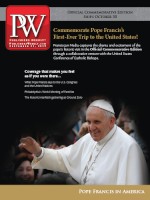With the Canadian dollar having sunk to 75¢ U.S. by mid September—the lowest it’s been against the U.S. dollar in more than 10 years—publishers north of the border are struggling with how to price their books, many of which are still priced at parity. The impact of the falling loonie isn’t all bad, however, as publishers that have significant sales to the U.S. are seeing a huge boost in revenue as a result of changes in the exchange rate.
“On our export sales into America, it’s fabulous,” says Sarah MacLachlan, House of Anansi Press’s president and publisher. “For Groundwood, our children’s list, 50% of that business comes out of America, so the falling loonie is beneficial to us in that way.”
Montreal’s Baraka Books, Victoria’s Orca Book Publishers, and Vancouver’s Greystone Books all say they have had increased revenue from the U.S. “It’s wonderful. It’s huge for us,” Greystone publisher Rob Sanders says. “We’re paying a bit more for books we print outside of Canada, but those are only the color books. Everything else we do print in Canada. Our revenue coming in from the United States and beyond is really helpful.”
Many publishers, however, are reluctantly considering adjusting their prices if the loonie’s downward trend continues, as it is predicted to do. Toronto’s Coach House Books already made the move earlier this year, and Arsenal Pulp Press, NeWest Press, and Linda Leith Publishing are pondering making the change.
“If the current exchange rate does continue, I think we’re going to have to revisit pricing,” Arsenal publisher Brian Lam says. “I know we have had inquiries from some Canadian retailers about our pricing. We can’t increase prices, so we have to reduce prices, because we’re always getting pressure from sales reps and booksellers to be as competitive as possible.”
Simon & Schuster Canada president Kevin Hanson believes that the currency fluctuation is a “huge deal,” as all importers, including the bookstore chain Indigo, are seeing their costs rise quickly. “So the question is, can you transfer the 20% in new costs to the consumer? And the answer is, not so fast,” Hanson says. “Domestic publishers are neutralized. But the reality is that 70% of all books sold in Canada are imported from the U.S., so core business costs have just gone up.”
The exchange rate also can have a big effect, depending on what share of a publisher’s books are printed in Canada versus the U.S. and abroad. Brad Martin, president and CEO of Penguin Random House Canada, says that the “vast majority” of the company’s Canadian books are produced in the U.S., and, as a result, production and fulfillment costs have risen 30%. It is also experiencing a negative impact on its distribution lists since pricing on backlist titles reflects a higher Canadian dollar.
Taryn Boyd, of TouchWood Editions, and Chouette Publishing’s Simon Payette both say they’ve seen a considerable increase in the price quotes they’re getting from printers in China, where some of their books are printed. Mosaic Books, which also prints some books in China, has reverted to having more books printed in Canada, according to managing director Matt Goody.
Sandra Kasturi, copublisher of Toronto’s ChiZine Publications, has also noticed increased costs for attending conferences and other industry events in the U.S. “Just paying for BookExpo America, with the actual cost of it after the exchange rate, I had to go sit on my fainting couch with the smelling salts afterward,” she says.



 Volume 262
Issue 38
09/21/2015
Volume 262
Issue 38
09/21/2015





